Human Resource Management Report: HRM in Morrisons Organization
VerifiedAdded on 2022/12/28
|9
|2895
|1
Report
AI Summary
This report provides a comprehensive analysis of Human Resource Management (HRM) practices within the context of Morrisons. It begins with an introduction to HRM, tracing its historical roots and defining its contemporary relevance. The main body of the report delves into various HRM models, with a focus on the Fombrun and Harvard models, and how they are applied within the organization. It explores the changing nature of employment relationships, emphasizing the importance of maintaining positive employee-employer dynamics. Strategic HRM use is examined, highlighting how Morrisons develops and implements strategies to align with its goals. The report traces the evolution of HRM, from historical practices to modern approaches. Key HRM functions, including recruitment, selection, training and development, career management, and reward management, are each discussed in detail, with specific examples from Morrisons. Additionally, the report addresses basic employment legislation, underscoring its importance in creating a fair and secure work environment. The report concludes with a summary of the findings, emphasizing the significance of effective HRM in driving organizational success.
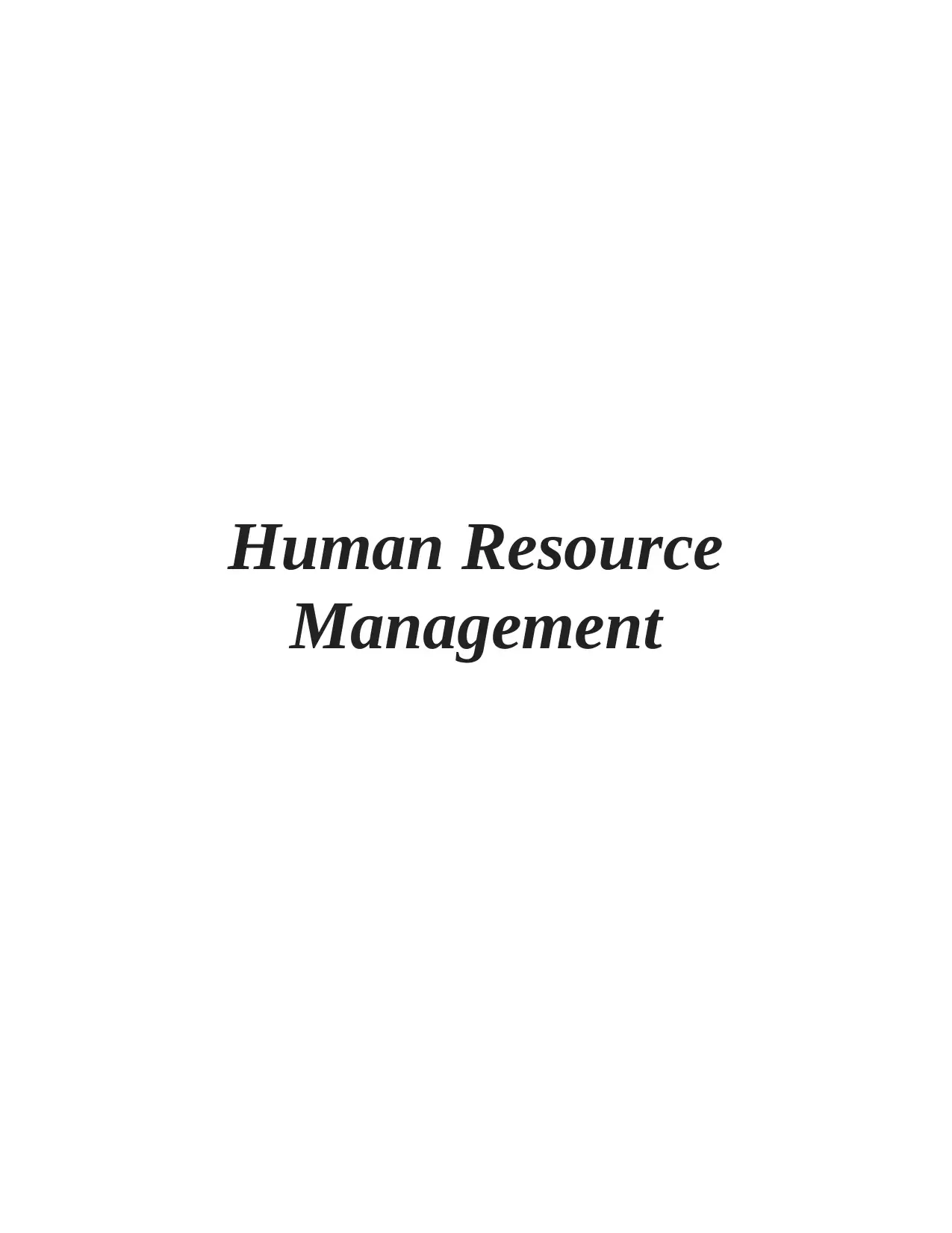
Human Resource
Management
Management
Paraphrase This Document
Need a fresh take? Get an instant paraphrase of this document with our AI Paraphraser
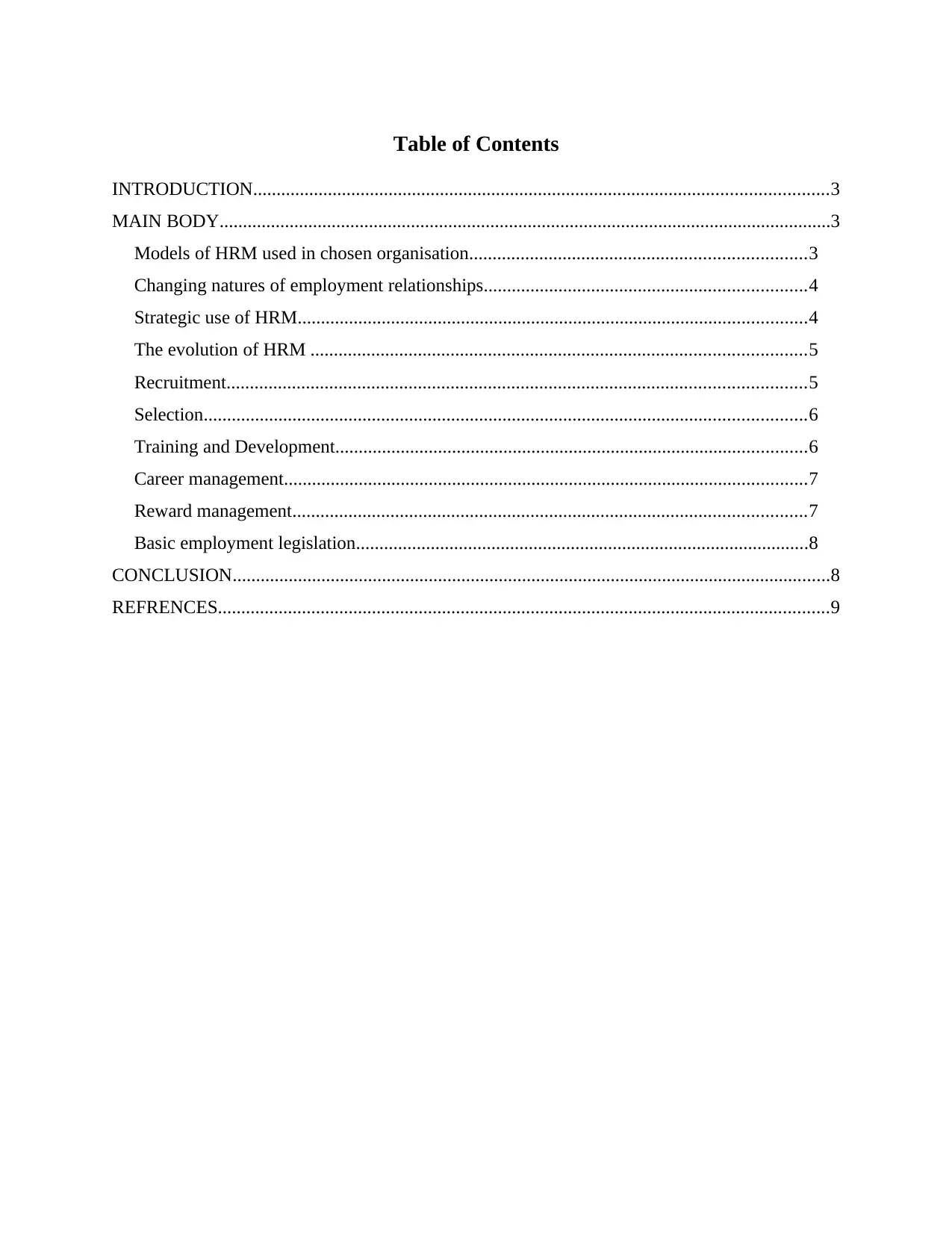
Table of Contents
INTRODUCTION...........................................................................................................................3
MAIN BODY...................................................................................................................................3
Models of HRM used in chosen organisation........................................................................3
Changing natures of employment relationships.....................................................................4
Strategic use of HRM.............................................................................................................4
The evolution of HRM ..........................................................................................................5
Recruitment............................................................................................................................5
Selection.................................................................................................................................6
Training and Development.....................................................................................................6
Career management................................................................................................................7
Reward management..............................................................................................................7
Basic employment legislation.................................................................................................8
CONCLUSION................................................................................................................................8
REFRENCES...................................................................................................................................9
INTRODUCTION...........................................................................................................................3
MAIN BODY...................................................................................................................................3
Models of HRM used in chosen organisation........................................................................3
Changing natures of employment relationships.....................................................................4
Strategic use of HRM.............................................................................................................4
The evolution of HRM ..........................................................................................................5
Recruitment............................................................................................................................5
Selection.................................................................................................................................6
Training and Development.....................................................................................................6
Career management................................................................................................................7
Reward management..............................................................................................................7
Basic employment legislation.................................................................................................8
CONCLUSION................................................................................................................................8
REFRENCES...................................................................................................................................9
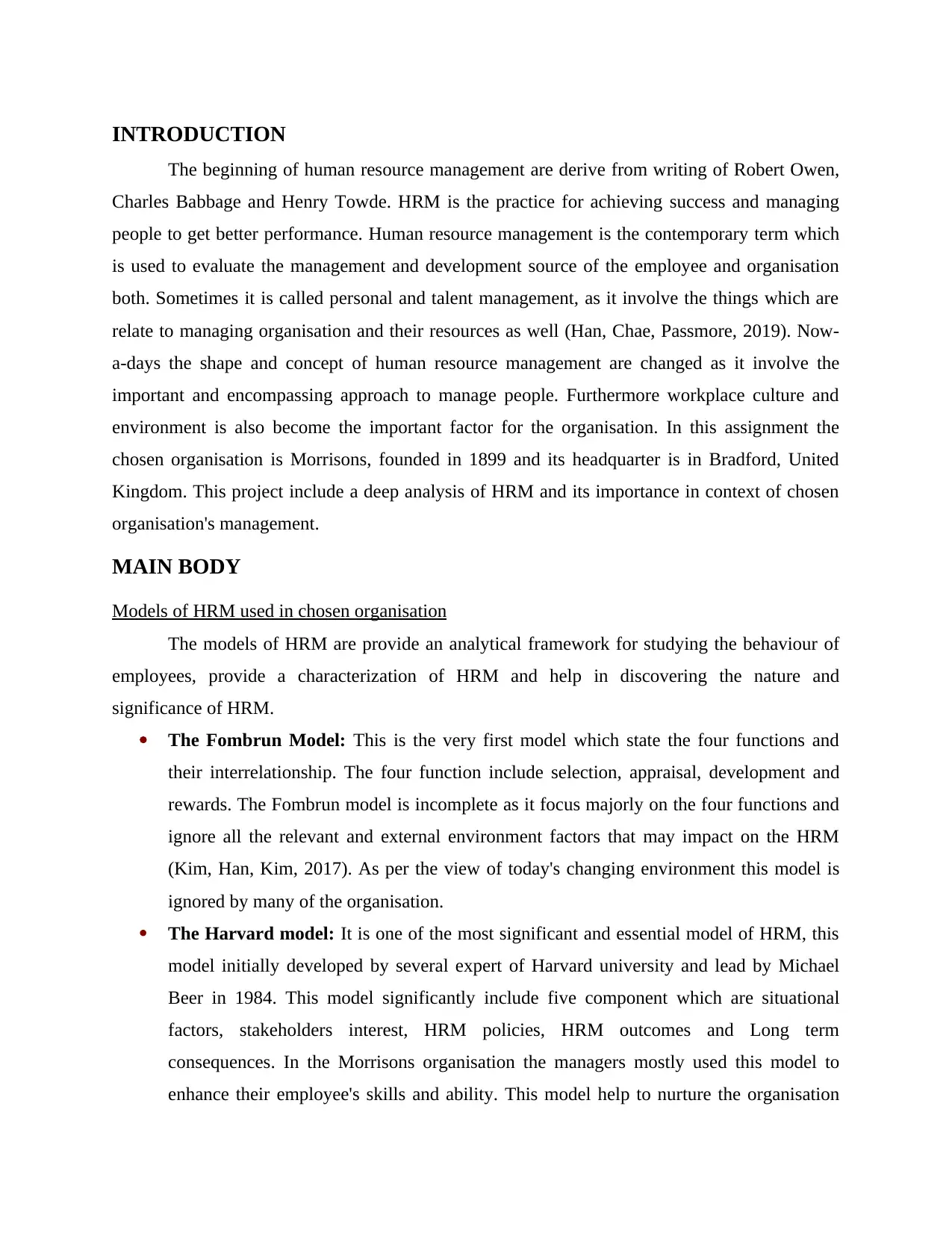
INTRODUCTION
The beginning of human resource management are derive from writing of Robert Owen,
Charles Babbage and Henry Towde. HRM is the practice for achieving success and managing
people to get better performance. Human resource management is the contemporary term which
is used to evaluate the management and development source of the employee and organisation
both. Sometimes it is called personal and talent management, as it involve the things which are
relate to managing organisation and their resources as well (Han, Chae, Passmore, 2019). Now-
a-days the shape and concept of human resource management are changed as it involve the
important and encompassing approach to manage people. Furthermore workplace culture and
environment is also become the important factor for the organisation. In this assignment the
chosen organisation is Morrisons, founded in 1899 and its headquarter is in Bradford, United
Kingdom. This project include a deep analysis of HRM and its importance in context of chosen
organisation's management.
MAIN BODY
Models of HRM used in chosen organisation
The models of HRM are provide an analytical framework for studying the behaviour of
employees, provide a characterization of HRM and help in discovering the nature and
significance of HRM.
The Fombrun Model: This is the very first model which state the four functions and
their interrelationship. The four function include selection, appraisal, development and
rewards. The Fombrun model is incomplete as it focus majorly on the four functions and
ignore all the relevant and external environment factors that may impact on the HRM
(Kim, Han, Kim, 2017). As per the view of today's changing environment this model is
ignored by many of the organisation.
The Harvard model: It is one of the most significant and essential model of HRM, this
model initially developed by several expert of Harvard university and lead by Michael
Beer in 1984. This model significantly include five component which are situational
factors, stakeholders interest, HRM policies, HRM outcomes and Long term
consequences. In the Morrisons organisation the managers mostly used this model to
enhance their employee's skills and ability. This model help to nurture the organisation
The beginning of human resource management are derive from writing of Robert Owen,
Charles Babbage and Henry Towde. HRM is the practice for achieving success and managing
people to get better performance. Human resource management is the contemporary term which
is used to evaluate the management and development source of the employee and organisation
both. Sometimes it is called personal and talent management, as it involve the things which are
relate to managing organisation and their resources as well (Han, Chae, Passmore, 2019). Now-
a-days the shape and concept of human resource management are changed as it involve the
important and encompassing approach to manage people. Furthermore workplace culture and
environment is also become the important factor for the organisation. In this assignment the
chosen organisation is Morrisons, founded in 1899 and its headquarter is in Bradford, United
Kingdom. This project include a deep analysis of HRM and its importance in context of chosen
organisation's management.
MAIN BODY
Models of HRM used in chosen organisation
The models of HRM are provide an analytical framework for studying the behaviour of
employees, provide a characterization of HRM and help in discovering the nature and
significance of HRM.
The Fombrun Model: This is the very first model which state the four functions and
their interrelationship. The four function include selection, appraisal, development and
rewards. The Fombrun model is incomplete as it focus majorly on the four functions and
ignore all the relevant and external environment factors that may impact on the HRM
(Kim, Han, Kim, 2017). As per the view of today's changing environment this model is
ignored by many of the organisation.
The Harvard model: It is one of the most significant and essential model of HRM, this
model initially developed by several expert of Harvard university and lead by Michael
Beer in 1984. This model significantly include five component which are situational
factors, stakeholders interest, HRM policies, HRM outcomes and Long term
consequences. In the Morrisons organisation the managers mostly used this model to
enhance their employee's skills and ability. This model help to nurture the organisation
⊘ This is a preview!⊘
Do you want full access?
Subscribe today to unlock all pages.

Trusted by 1+ million students worldwide
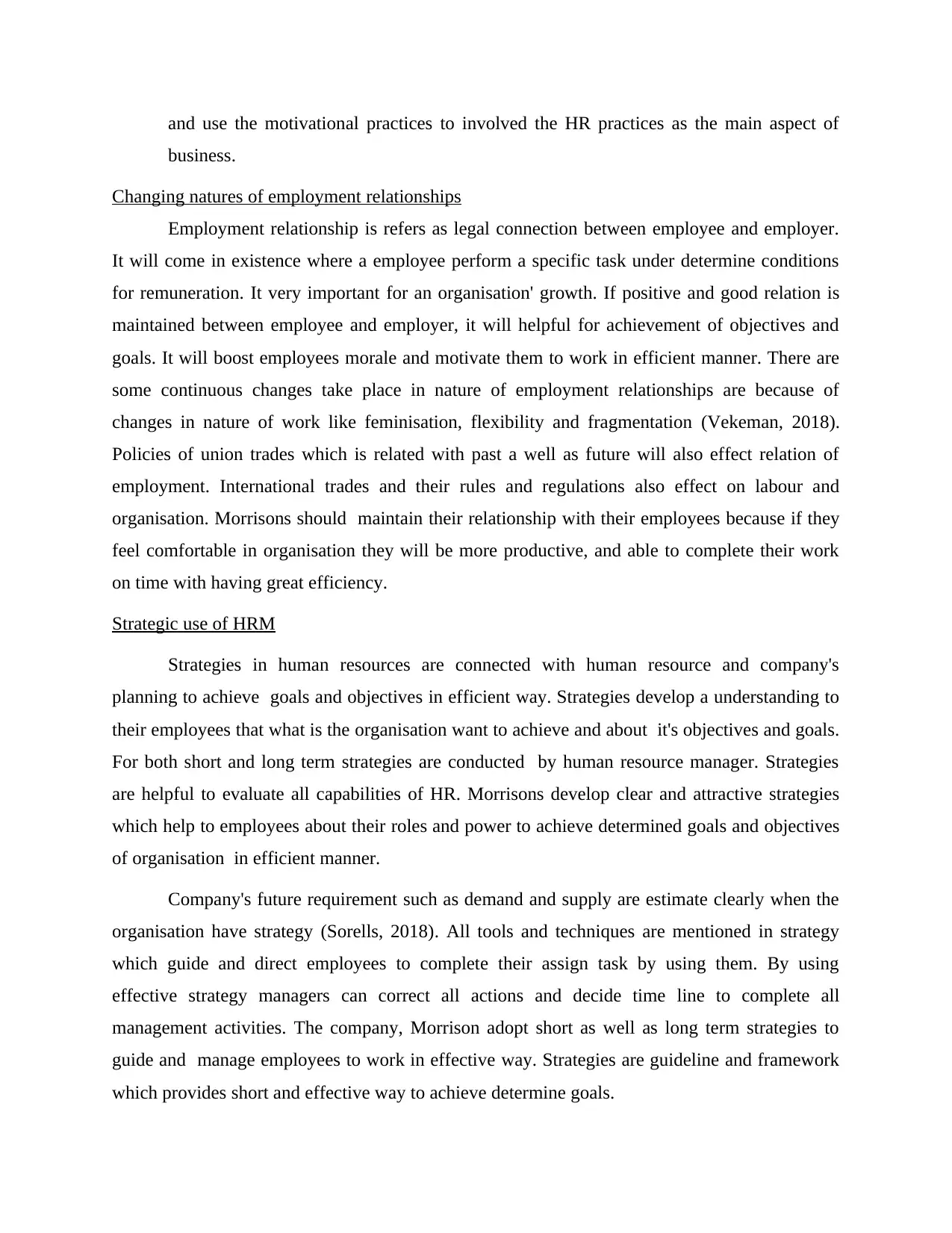
and use the motivational practices to involved the HR practices as the main aspect of
business.
Changing natures of employment relationships
Employment relationship is refers as legal connection between employee and employer.
It will come in existence where a employee perform a specific task under determine conditions
for remuneration. It very important for an organisation' growth. If positive and good relation is
maintained between employee and employer, it will helpful for achievement of objectives and
goals. It will boost employees morale and motivate them to work in efficient manner. There are
some continuous changes take place in nature of employment relationships are because of
changes in nature of work like feminisation, flexibility and fragmentation (Vekeman, 2018).
Policies of union trades which is related with past a well as future will also effect relation of
employment. International trades and their rules and regulations also effect on labour and
organisation. Morrisons should maintain their relationship with their employees because if they
feel comfortable in organisation they will be more productive, and able to complete their work
on time with having great efficiency.
Strategic use of HRM
Strategies in human resources are connected with human resource and company's
planning to achieve goals and objectives in efficient way. Strategies develop a understanding to
their employees that what is the organisation want to achieve and about it's objectives and goals.
For both short and long term strategies are conducted by human resource manager. Strategies
are helpful to evaluate all capabilities of HR. Morrisons develop clear and attractive strategies
which help to employees about their roles and power to achieve determined goals and objectives
of organisation in efficient manner.
Company's future requirement such as demand and supply are estimate clearly when the
organisation have strategy (Sorells, 2018). All tools and techniques are mentioned in strategy
which guide and direct employees to complete their assign task by using them. By using
effective strategy managers can correct all actions and decide time line to complete all
management activities. The company, Morrison adopt short as well as long term strategies to
guide and manage employees to work in effective way. Strategies are guideline and framework
which provides short and effective way to achieve determine goals.
business.
Changing natures of employment relationships
Employment relationship is refers as legal connection between employee and employer.
It will come in existence where a employee perform a specific task under determine conditions
for remuneration. It very important for an organisation' growth. If positive and good relation is
maintained between employee and employer, it will helpful for achievement of objectives and
goals. It will boost employees morale and motivate them to work in efficient manner. There are
some continuous changes take place in nature of employment relationships are because of
changes in nature of work like feminisation, flexibility and fragmentation (Vekeman, 2018).
Policies of union trades which is related with past a well as future will also effect relation of
employment. International trades and their rules and regulations also effect on labour and
organisation. Morrisons should maintain their relationship with their employees because if they
feel comfortable in organisation they will be more productive, and able to complete their work
on time with having great efficiency.
Strategic use of HRM
Strategies in human resources are connected with human resource and company's
planning to achieve goals and objectives in efficient way. Strategies develop a understanding to
their employees that what is the organisation want to achieve and about it's objectives and goals.
For both short and long term strategies are conducted by human resource manager. Strategies
are helpful to evaluate all capabilities of HR. Morrisons develop clear and attractive strategies
which help to employees about their roles and power to achieve determined goals and objectives
of organisation in efficient manner.
Company's future requirement such as demand and supply are estimate clearly when the
organisation have strategy (Sorells, 2018). All tools and techniques are mentioned in strategy
which guide and direct employees to complete their assign task by using them. By using
effective strategy managers can correct all actions and decide time line to complete all
management activities. The company, Morrison adopt short as well as long term strategies to
guide and manage employees to work in effective way. Strategies are guideline and framework
which provides short and effective way to achieve determine goals.
Paraphrase This Document
Need a fresh take? Get an instant paraphrase of this document with our AI Paraphraser
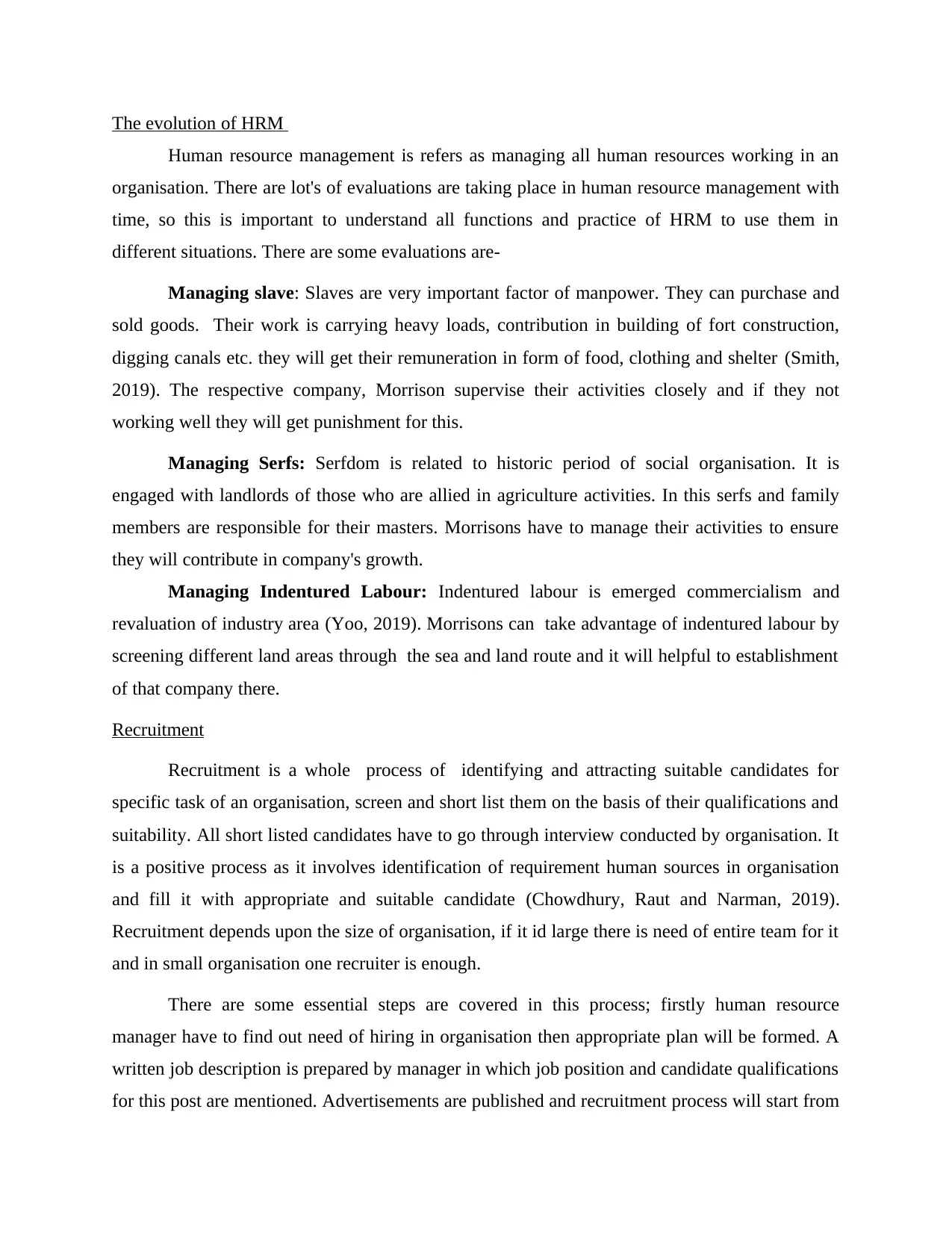
The evolution of HRM
Human resource management is refers as managing all human resources working in an
organisation. There are lot's of evaluations are taking place in human resource management with
time, so this is important to understand all functions and practice of HRM to use them in
different situations. There are some evaluations are-
Managing slave: Slaves are very important factor of manpower. They can purchase and
sold goods. Their work is carrying heavy loads, contribution in building of fort construction,
digging canals etc. they will get their remuneration in form of food, clothing and shelter (Smith,
2019). The respective company, Morrison supervise their activities closely and if they not
working well they will get punishment for this.
Managing Serfs: Serfdom is related to historic period of social organisation. It is
engaged with landlords of those who are allied in agriculture activities. In this serfs and family
members are responsible for their masters. Morrisons have to manage their activities to ensure
they will contribute in company's growth.
Managing Indentured Labour: Indentured labour is emerged commercialism and
revaluation of industry area (Yoo, 2019). Morrisons can take advantage of indentured labour by
screening different land areas through the sea and land route and it will helpful to establishment
of that company there.
Recruitment
Recruitment is a whole process of identifying and attracting suitable candidates for
specific task of an organisation, screen and short list them on the basis of their qualifications and
suitability. All short listed candidates have to go through interview conducted by organisation. It
is a positive process as it involves identification of requirement human sources in organisation
and fill it with appropriate and suitable candidate (Chowdhury, Raut and Narman, 2019).
Recruitment depends upon the size of organisation, if it id large there is need of entire team for it
and in small organisation one recruiter is enough.
There are some essential steps are covered in this process; firstly human resource
manager have to find out need of hiring in organisation then appropriate plan will be formed. A
written job description is prepared by manager in which job position and candidate qualifications
for this post are mentioned. Advertisements are published and recruitment process will start from
Human resource management is refers as managing all human resources working in an
organisation. There are lot's of evaluations are taking place in human resource management with
time, so this is important to understand all functions and practice of HRM to use them in
different situations. There are some evaluations are-
Managing slave: Slaves are very important factor of manpower. They can purchase and
sold goods. Their work is carrying heavy loads, contribution in building of fort construction,
digging canals etc. they will get their remuneration in form of food, clothing and shelter (Smith,
2019). The respective company, Morrison supervise their activities closely and if they not
working well they will get punishment for this.
Managing Serfs: Serfdom is related to historic period of social organisation. It is
engaged with landlords of those who are allied in agriculture activities. In this serfs and family
members are responsible for their masters. Morrisons have to manage their activities to ensure
they will contribute in company's growth.
Managing Indentured Labour: Indentured labour is emerged commercialism and
revaluation of industry area (Yoo, 2019). Morrisons can take advantage of indentured labour by
screening different land areas through the sea and land route and it will helpful to establishment
of that company there.
Recruitment
Recruitment is a whole process of identifying and attracting suitable candidates for
specific task of an organisation, screen and short list them on the basis of their qualifications and
suitability. All short listed candidates have to go through interview conducted by organisation. It
is a positive process as it involves identification of requirement human sources in organisation
and fill it with appropriate and suitable candidate (Chowdhury, Raut and Narman, 2019).
Recruitment depends upon the size of organisation, if it id large there is need of entire team for it
and in small organisation one recruiter is enough.
There are some essential steps are covered in this process; firstly human resource
manager have to find out need of hiring in organisation then appropriate plan will be formed. A
written job description is prepared by manager in which job position and candidate qualifications
for this post are mentioned. Advertisements are published and recruitment process will start from
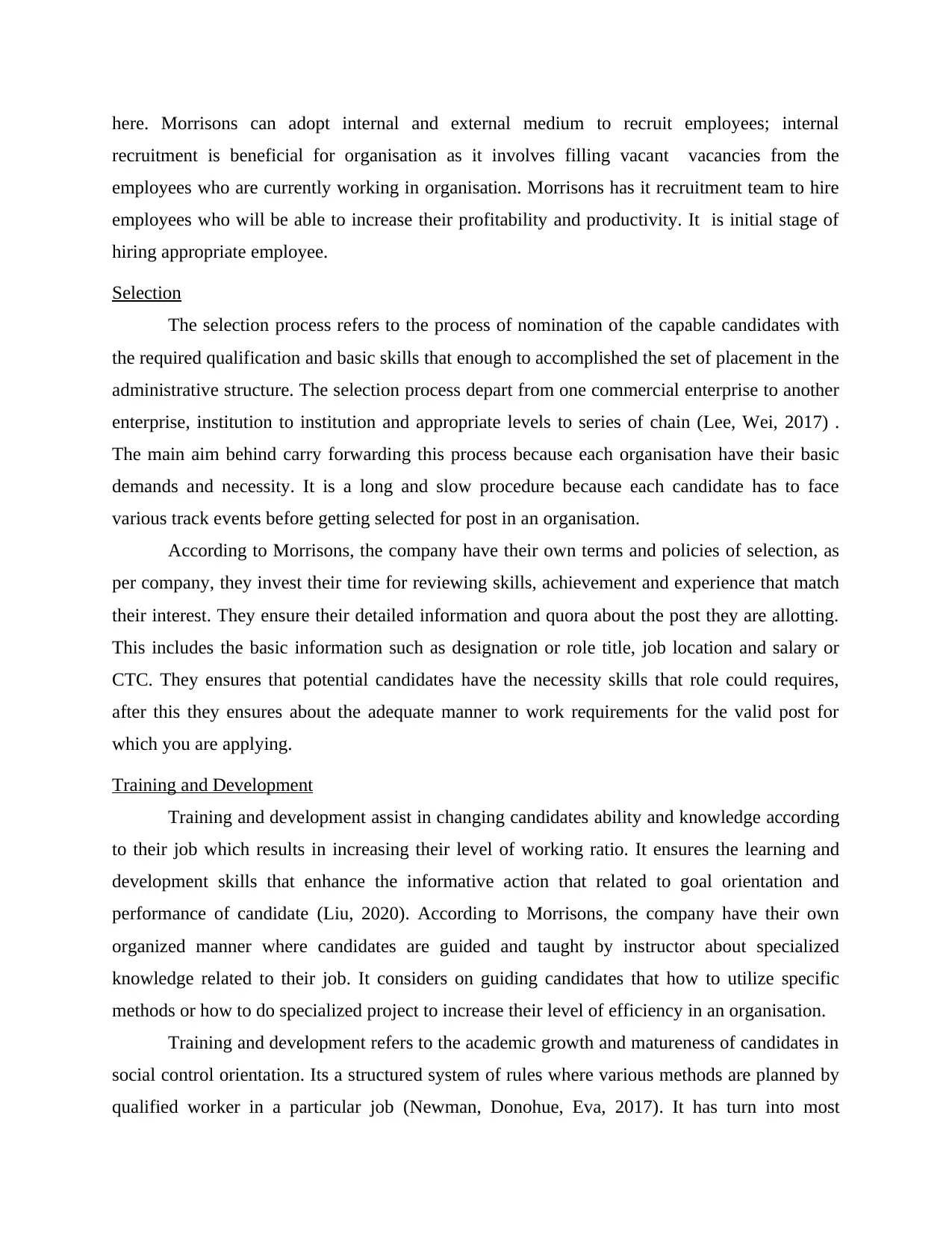
here. Morrisons can adopt internal and external medium to recruit employees; internal
recruitment is beneficial for organisation as it involves filling vacant vacancies from the
employees who are currently working in organisation. Morrisons has it recruitment team to hire
employees who will be able to increase their profitability and productivity. It is initial stage of
hiring appropriate employee.
Selection
The selection process refers to the process of nomination of the capable candidates with
the required qualification and basic skills that enough to accomplished the set of placement in the
administrative structure. The selection process depart from one commercial enterprise to another
enterprise, institution to institution and appropriate levels to series of chain (Lee, Wei, 2017) .
The main aim behind carry forwarding this process because each organisation have their basic
demands and necessity. It is a long and slow procedure because each candidate has to face
various track events before getting selected for post in an organisation.
According to Morrisons, the company have their own terms and policies of selection, as
per company, they invest their time for reviewing skills, achievement and experience that match
their interest. They ensure their detailed information and quora about the post they are allotting.
This includes the basic information such as designation or role title, job location and salary or
CTC. They ensures that potential candidates have the necessity skills that role could requires,
after this they ensures about the adequate manner to work requirements for the valid post for
which you are applying.
Training and Development
Training and development assist in changing candidates ability and knowledge according
to their job which results in increasing their level of working ratio. It ensures the learning and
development skills that enhance the informative action that related to goal orientation and
performance of candidate (Liu, 2020). According to Morrisons, the company have their own
organized manner where candidates are guided and taught by instructor about specialized
knowledge related to their job. It considers on guiding candidates that how to utilize specific
methods or how to do specialized project to increase their level of efficiency in an organisation.
Training and development refers to the academic growth and matureness of candidates in
social control orientation. Its a structured system of rules where various methods are planned by
qualified worker in a particular job (Newman, Donohue, Eva, 2017). It has turn into most
recruitment is beneficial for organisation as it involves filling vacant vacancies from the
employees who are currently working in organisation. Morrisons has it recruitment team to hire
employees who will be able to increase their profitability and productivity. It is initial stage of
hiring appropriate employee.
Selection
The selection process refers to the process of nomination of the capable candidates with
the required qualification and basic skills that enough to accomplished the set of placement in the
administrative structure. The selection process depart from one commercial enterprise to another
enterprise, institution to institution and appropriate levels to series of chain (Lee, Wei, 2017) .
The main aim behind carry forwarding this process because each organisation have their basic
demands and necessity. It is a long and slow procedure because each candidate has to face
various track events before getting selected for post in an organisation.
According to Morrisons, the company have their own terms and policies of selection, as
per company, they invest their time for reviewing skills, achievement and experience that match
their interest. They ensure their detailed information and quora about the post they are allotting.
This includes the basic information such as designation or role title, job location and salary or
CTC. They ensures that potential candidates have the necessity skills that role could requires,
after this they ensures about the adequate manner to work requirements for the valid post for
which you are applying.
Training and Development
Training and development assist in changing candidates ability and knowledge according
to their job which results in increasing their level of working ratio. It ensures the learning and
development skills that enhance the informative action that related to goal orientation and
performance of candidate (Liu, 2020). According to Morrisons, the company have their own
organized manner where candidates are guided and taught by instructor about specialized
knowledge related to their job. It considers on guiding candidates that how to utilize specific
methods or how to do specialized project to increase their level of efficiency in an organisation.
Training and development refers to the academic growth and matureness of candidates in
social control orientation. Its a structured system of rules where various methods are planned by
qualified worker in a particular job (Newman, Donohue, Eva, 2017). It has turn into most
⊘ This is a preview!⊘
Do you want full access?
Subscribe today to unlock all pages.

Trusted by 1+ million students worldwide
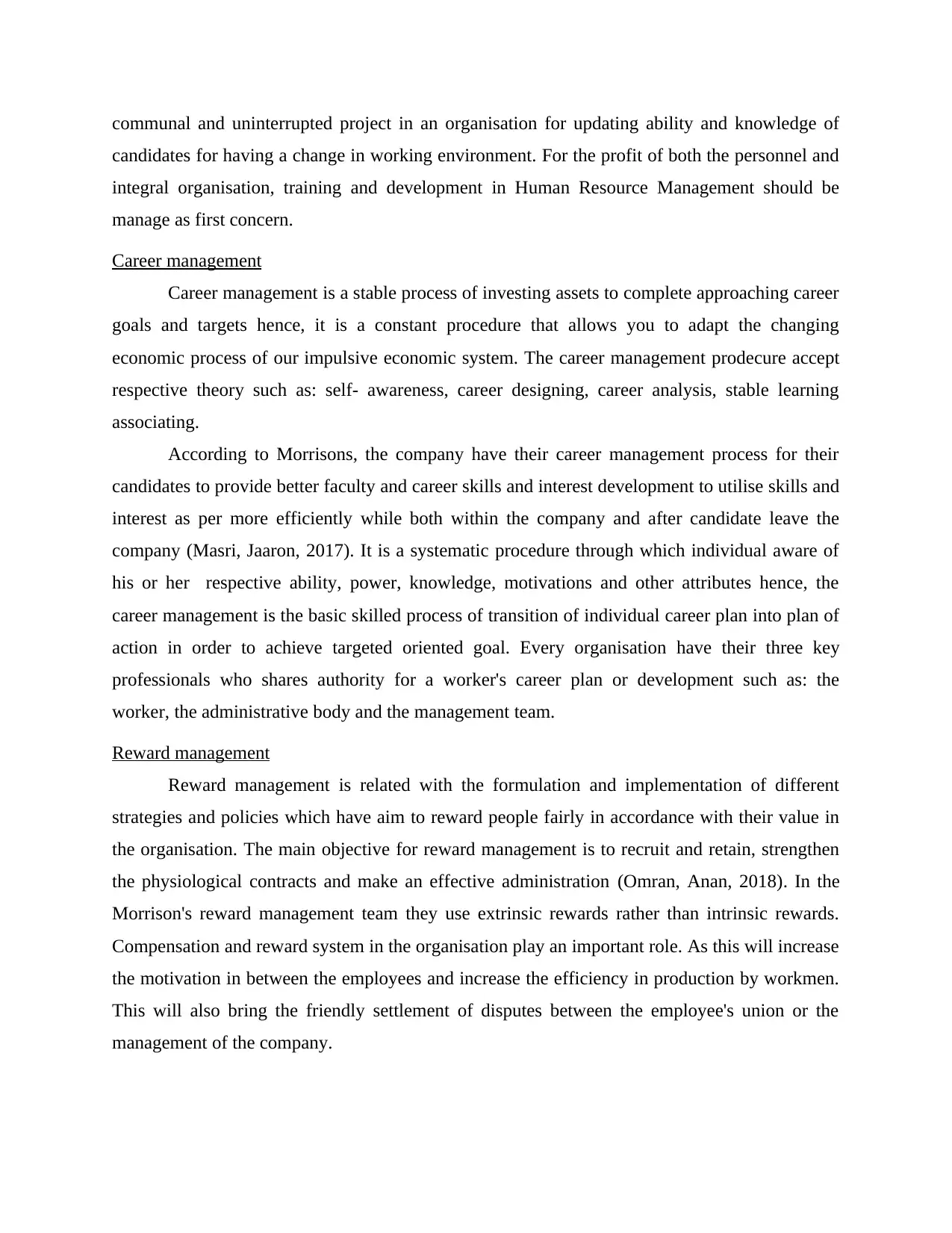
communal and uninterrupted project in an organisation for updating ability and knowledge of
candidates for having a change in working environment. For the profit of both the personnel and
integral organisation, training and development in Human Resource Management should be
manage as first concern.
Career management
Career management is a stable process of investing assets to complete approaching career
goals and targets hence, it is a constant procedure that allows you to adapt the changing
economic process of our impulsive economic system. The career management prodecure accept
respective theory such as: self- awareness, career designing, career analysis, stable learning
associating.
According to Morrisons, the company have their career management process for their
candidates to provide better faculty and career skills and interest development to utilise skills and
interest as per more efficiently while both within the company and after candidate leave the
company (Masri, Jaaron, 2017). It is a systematic procedure through which individual aware of
his or her respective ability, power, knowledge, motivations and other attributes hence, the
career management is the basic skilled process of transition of individual career plan into plan of
action in order to achieve targeted oriented goal. Every organisation have their three key
professionals who shares authority for a worker's career plan or development such as: the
worker, the administrative body and the management team.
Reward management
Reward management is related with the formulation and implementation of different
strategies and policies which have aim to reward people fairly in accordance with their value in
the organisation. The main objective for reward management is to recruit and retain, strengthen
the physiological contracts and make an effective administration (Omran, Anan, 2018). In the
Morrison's reward management team they use extrinsic rewards rather than intrinsic rewards.
Compensation and reward system in the organisation play an important role. As this will increase
the motivation in between the employees and increase the efficiency in production by workmen.
This will also bring the friendly settlement of disputes between the employee's union or the
management of the company.
candidates for having a change in working environment. For the profit of both the personnel and
integral organisation, training and development in Human Resource Management should be
manage as first concern.
Career management
Career management is a stable process of investing assets to complete approaching career
goals and targets hence, it is a constant procedure that allows you to adapt the changing
economic process of our impulsive economic system. The career management prodecure accept
respective theory such as: self- awareness, career designing, career analysis, stable learning
associating.
According to Morrisons, the company have their career management process for their
candidates to provide better faculty and career skills and interest development to utilise skills and
interest as per more efficiently while both within the company and after candidate leave the
company (Masri, Jaaron, 2017). It is a systematic procedure through which individual aware of
his or her respective ability, power, knowledge, motivations and other attributes hence, the
career management is the basic skilled process of transition of individual career plan into plan of
action in order to achieve targeted oriented goal. Every organisation have their three key
professionals who shares authority for a worker's career plan or development such as: the
worker, the administrative body and the management team.
Reward management
Reward management is related with the formulation and implementation of different
strategies and policies which have aim to reward people fairly in accordance with their value in
the organisation. The main objective for reward management is to recruit and retain, strengthen
the physiological contracts and make an effective administration (Omran, Anan, 2018). In the
Morrison's reward management team they use extrinsic rewards rather than intrinsic rewards.
Compensation and reward system in the organisation play an important role. As this will increase
the motivation in between the employees and increase the efficiency in production by workmen.
This will also bring the friendly settlement of disputes between the employee's union or the
management of the company.
Paraphrase This Document
Need a fresh take? Get an instant paraphrase of this document with our AI Paraphraser
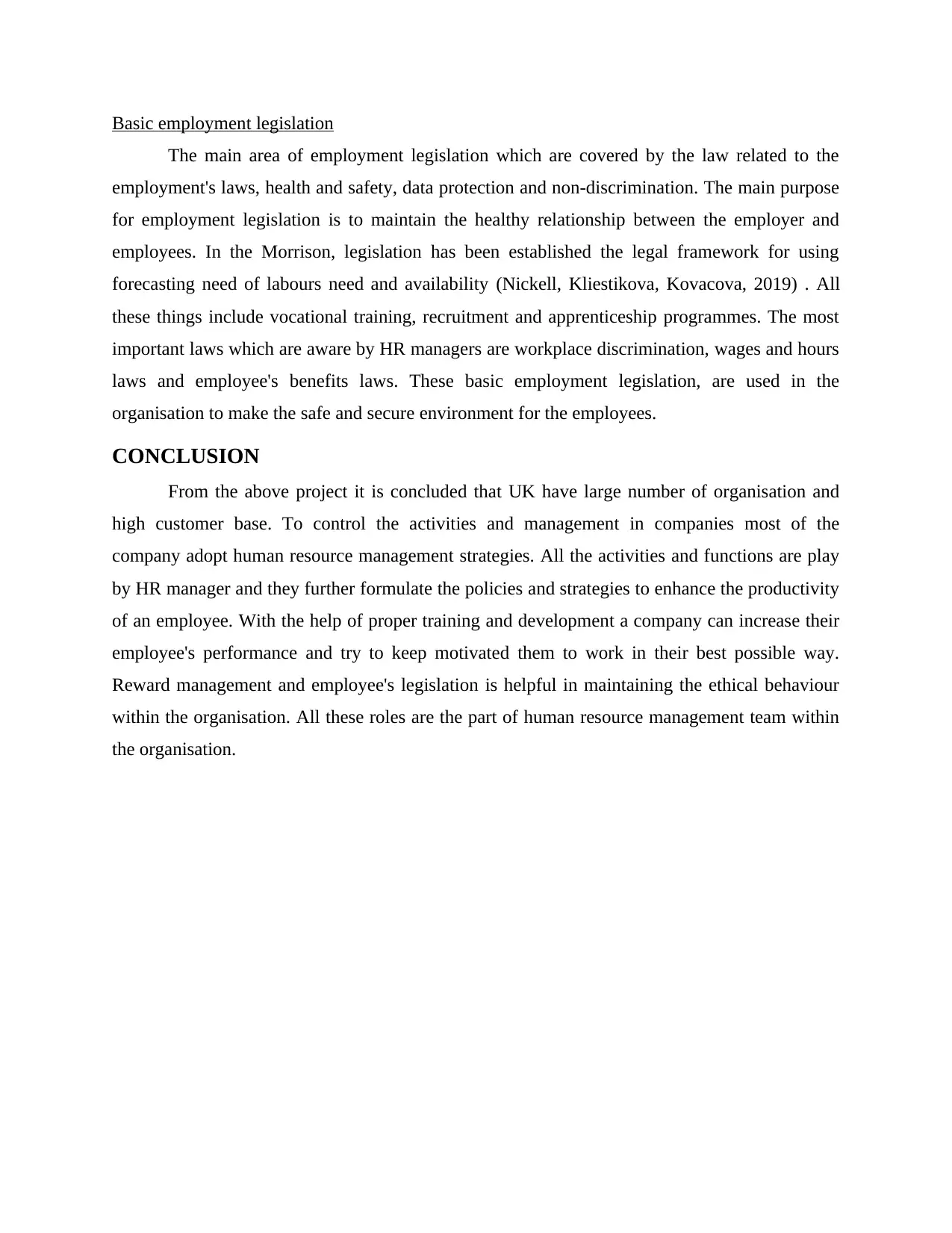
Basic employment legislation
The main area of employment legislation which are covered by the law related to the
employment's laws, health and safety, data protection and non-discrimination. The main purpose
for employment legislation is to maintain the healthy relationship between the employer and
employees. In the Morrison, legislation has been established the legal framework for using
forecasting need of labours need and availability (Nickell, Kliestikova, Kovacova, 2019) . All
these things include vocational training, recruitment and apprenticeship programmes. The most
important laws which are aware by HR managers are workplace discrimination, wages and hours
laws and employee's benefits laws. These basic employment legislation, are used in the
organisation to make the safe and secure environment for the employees.
CONCLUSION
From the above project it is concluded that UK have large number of organisation and
high customer base. To control the activities and management in companies most of the
company adopt human resource management strategies. All the activities and functions are play
by HR manager and they further formulate the policies and strategies to enhance the productivity
of an employee. With the help of proper training and development a company can increase their
employee's performance and try to keep motivated them to work in their best possible way.
Reward management and employee's legislation is helpful in maintaining the ethical behaviour
within the organisation. All these roles are the part of human resource management team within
the organisation.
The main area of employment legislation which are covered by the law related to the
employment's laws, health and safety, data protection and non-discrimination. The main purpose
for employment legislation is to maintain the healthy relationship between the employer and
employees. In the Morrison, legislation has been established the legal framework for using
forecasting need of labours need and availability (Nickell, Kliestikova, Kovacova, 2019) . All
these things include vocational training, recruitment and apprenticeship programmes. The most
important laws which are aware by HR managers are workplace discrimination, wages and hours
laws and employee's benefits laws. These basic employment legislation, are used in the
organisation to make the safe and secure environment for the employees.
CONCLUSION
From the above project it is concluded that UK have large number of organisation and
high customer base. To control the activities and management in companies most of the
company adopt human resource management strategies. All the activities and functions are play
by HR manager and they further formulate the policies and strategies to enhance the productivity
of an employee. With the help of proper training and development a company can increase their
employee's performance and try to keep motivated them to work in their best possible way.
Reward management and employee's legislation is helpful in maintaining the ethical behaviour
within the organisation. All these roles are the part of human resource management team within
the organisation.
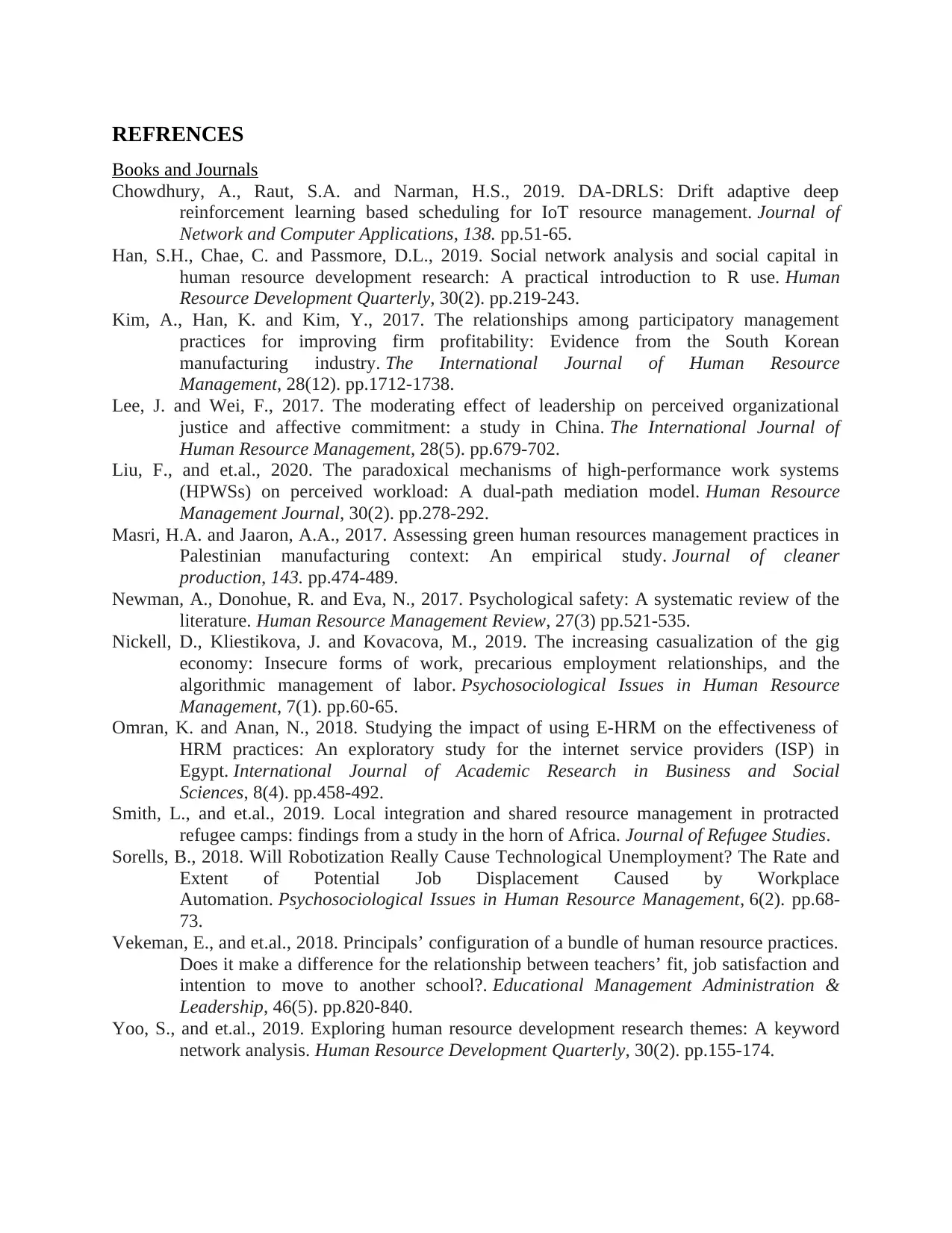
REFRENCES
Books and Journals
Chowdhury, A., Raut, S.A. and Narman, H.S., 2019. DA-DRLS: Drift adaptive deep
reinforcement learning based scheduling for IoT resource management. Journal of
Network and Computer Applications, 138. pp.51-65.
Han, S.H., Chae, C. and Passmore, D.L., 2019. Social network analysis and social capital in
human resource development research: A practical introduction to R use. Human
Resource Development Quarterly, 30(2). pp.219-243.
Kim, A., Han, K. and Kim, Y., 2017. The relationships among participatory management
practices for improving firm profitability: Evidence from the South Korean
manufacturing industry. The International Journal of Human Resource
Management, 28(12). pp.1712-1738.
Lee, J. and Wei, F., 2017. The moderating effect of leadership on perceived organizational
justice and affective commitment: a study in China. The International Journal of
Human Resource Management, 28(5). pp.679-702.
Liu, F., and et.al., 2020. The paradoxical mechanisms of high‐performance work systems
(HPWSs) on perceived workload: A dual‐path mediation model. Human Resource
Management Journal, 30(2). pp.278-292.
Masri, H.A. and Jaaron, A.A., 2017. Assessing green human resources management practices in
Palestinian manufacturing context: An empirical study. Journal of cleaner
production, 143. pp.474-489.
Newman, A., Donohue, R. and Eva, N., 2017. Psychological safety: A systematic review of the
literature. Human Resource Management Review, 27(3) pp.521-535.
Nickell, D., Kliestikova, J. and Kovacova, M., 2019. The increasing casualization of the gig
economy: Insecure forms of work, precarious employment relationships, and the
algorithmic management of labor. Psychosociological Issues in Human Resource
Management, 7(1). pp.60-65.
Omran, K. and Anan, N., 2018. Studying the impact of using E-HRM on the effectiveness of
HRM practices: An exploratory study for the internet service providers (ISP) in
Egypt. International Journal of Academic Research in Business and Social
Sciences, 8(4). pp.458-492.
Smith, L., and et.al., 2019. Local integration and shared resource management in protracted
refugee camps: findings from a study in the horn of Africa. Journal of Refugee Studies.
Sorells, B., 2018. Will Robotization Really Cause Technological Unemployment? The Rate and
Extent of Potential Job Displacement Caused by Workplace
Automation. Psychosociological Issues in Human Resource Management, 6(2). pp.68-
73.
Vekeman, E., and et.al., 2018. Principals’ configuration of a bundle of human resource practices.
Does it make a difference for the relationship between teachers’ fit, job satisfaction and
intention to move to another school?. Educational Management Administration &
Leadership, 46(5). pp.820-840.
Yoo, S., and et.al., 2019. Exploring human resource development research themes: A keyword
network analysis. Human Resource Development Quarterly, 30(2). pp.155-174.
Books and Journals
Chowdhury, A., Raut, S.A. and Narman, H.S., 2019. DA-DRLS: Drift adaptive deep
reinforcement learning based scheduling for IoT resource management. Journal of
Network and Computer Applications, 138. pp.51-65.
Han, S.H., Chae, C. and Passmore, D.L., 2019. Social network analysis and social capital in
human resource development research: A practical introduction to R use. Human
Resource Development Quarterly, 30(2). pp.219-243.
Kim, A., Han, K. and Kim, Y., 2017. The relationships among participatory management
practices for improving firm profitability: Evidence from the South Korean
manufacturing industry. The International Journal of Human Resource
Management, 28(12). pp.1712-1738.
Lee, J. and Wei, F., 2017. The moderating effect of leadership on perceived organizational
justice and affective commitment: a study in China. The International Journal of
Human Resource Management, 28(5). pp.679-702.
Liu, F., and et.al., 2020. The paradoxical mechanisms of high‐performance work systems
(HPWSs) on perceived workload: A dual‐path mediation model. Human Resource
Management Journal, 30(2). pp.278-292.
Masri, H.A. and Jaaron, A.A., 2017. Assessing green human resources management practices in
Palestinian manufacturing context: An empirical study. Journal of cleaner
production, 143. pp.474-489.
Newman, A., Donohue, R. and Eva, N., 2017. Psychological safety: A systematic review of the
literature. Human Resource Management Review, 27(3) pp.521-535.
Nickell, D., Kliestikova, J. and Kovacova, M., 2019. The increasing casualization of the gig
economy: Insecure forms of work, precarious employment relationships, and the
algorithmic management of labor. Psychosociological Issues in Human Resource
Management, 7(1). pp.60-65.
Omran, K. and Anan, N., 2018. Studying the impact of using E-HRM on the effectiveness of
HRM practices: An exploratory study for the internet service providers (ISP) in
Egypt. International Journal of Academic Research in Business and Social
Sciences, 8(4). pp.458-492.
Smith, L., and et.al., 2019. Local integration and shared resource management in protracted
refugee camps: findings from a study in the horn of Africa. Journal of Refugee Studies.
Sorells, B., 2018. Will Robotization Really Cause Technological Unemployment? The Rate and
Extent of Potential Job Displacement Caused by Workplace
Automation. Psychosociological Issues in Human Resource Management, 6(2). pp.68-
73.
Vekeman, E., and et.al., 2018. Principals’ configuration of a bundle of human resource practices.
Does it make a difference for the relationship between teachers’ fit, job satisfaction and
intention to move to another school?. Educational Management Administration &
Leadership, 46(5). pp.820-840.
Yoo, S., and et.al., 2019. Exploring human resource development research themes: A keyword
network analysis. Human Resource Development Quarterly, 30(2). pp.155-174.
⊘ This is a preview!⊘
Do you want full access?
Subscribe today to unlock all pages.

Trusted by 1+ million students worldwide
1 out of 9
Related Documents
Your All-in-One AI-Powered Toolkit for Academic Success.
+13062052269
info@desklib.com
Available 24*7 on WhatsApp / Email
![[object Object]](/_next/static/media/star-bottom.7253800d.svg)
Unlock your academic potential
Copyright © 2020–2025 A2Z Services. All Rights Reserved. Developed and managed by ZUCOL.





